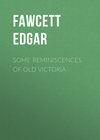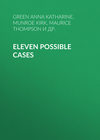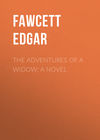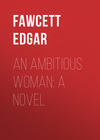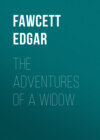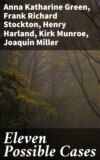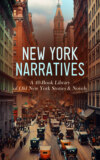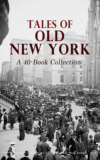Читать книгу: «Some Reminiscences of old Victoria», страница 16
Barclay and I reached our quarters at the Hotel de France about midnight. We were a pair of thoroughly happy mortals, for had we not, after all, "dined out," and had we not had a royal good time on Christmas Day, 1860?
The morrow was Boxing Day and none of the offices were opened. I saw nothing of the Princess; but I observed Bertie, the sweet "child," as he paid frequent visits to the bar and filled himself to the throttle with brandy and water and rum and gin and bought and paid for and smoked the best cigars at two bits each. As I gazed upon him the desire to give him a kicking grew stronger.
By appointment Barclay and I met in a private room at the hotel, where he unfolded his plans.
"You must have seen," he began, "that Miss Forbes and I are warm friends. Our friendship began six months ago. I proposed to her and was accepted subject to the approval of the father. He refused to give his consent because, having lost his money, he could not give his daughter a dowry. It was in vain I urged that I had sufficient for both. He would listen to nothing that involved an acceptance of assistance from me, and he left for Vancouver Island to try his fortunes here. He fell ill and they have sold or pawned everything of value. The girl was not permitted to bid me good-bye when they left Grass Valley. After their departure the discovery of which I have informed you was made in the Maloney tunnel and as Mr. Forbes has held on to a control of the stock in spite of his adversities, he is now a rich man. I want to marry the girl. As I told you, I proposed when I believed them to be ruined. It is now my duty to acquaint the family with their good fortune and renew my suit. I think I ought to do it to-day. Surely he will not repel me now when I take that news to him, as he did on Christmas morning when I tendered him a loan."
I told him I thought he should impart the good news at once and stand the consequences. He left me for that purpose. As I walked into the dining-room, I saw the dear "child" Bertrand leaning over the bar quaffing a glass of absinthe. When he saw me he gulped down the drink and said:
"Mamma would like to speak to you – she thought you would have called."
I recalled the adventure with the eyes and hesitated. Then I decided to go to room 12 on the second flat and see the thing out. A knock on the door was responded to by a sweet "Come in." Mme. Fabre was seated in an easy chair before a cheerful coal fire.
She arose at once and extended a plump and white hand. As we seated ourselves she flashed those burning eyes upon me and said:
"I am so glad you have come! I do want your advice about my mining venture. In the first place I may tell you that I have found the man who owns the shares. He is here in Victoria with his family. He is desperately poor. A hundred dollars if offered would be a great temptation. I would give more – five hundred if necessary."
"The property you told me of the other day is valuable, is it not?" I asked.
"Yes – that is to say, we think it is. You know that mining is the most uncertain of all ventures. You may imagine you are rich one day and the next you find yourself broke. It was so with my husband. He came home one day and said, ‘We are rich’; and the next he said, ‘We are poor.’ This Maloney mine looks well, but who can be sure? When I came here I thought that if I found the man with the shares I could get them for a song. I may yet, but my dear child tells me that he has seen here a man from Grass Valley named Barclay who is a friend of that shareholder, and," she added, bitterly, "perhaps he has got ahead of me. I must see the man at once and make him an offer. What do you think?"
"I think you might as well save yourself further trouble. By this time the shareholder has been apprised of his good fortune."
"What!" she exclaimed, springing to her feet and transfixing me with her eyes. "Am I, then, too late?"
"Yes," I said, "you are too late. Forbes – that is the man’s name – knows of his good fortune and I do not believe he would sell now at any price."
The woman gazed at me with the concentrated hate of a thousand furies. Her great eyes no longer bore an expression of pleading tenderness – they seemed to glint and expand and to shoot fierce flames from their depths. They no longer charmed, they terrified me! How I wished I had left the door open.
"Ah!" she screamed. "I see it all. I have been betrayed – sold out. You have broken my confidence."
"I have done nothing of the kind. I have never repeated to a soul what you told me."
"Then who could have done it?" she exclaimed, bursting into a fit of hysterical tears. "I have come all this way to secure the property and now find that I am too late. Shame! shame!"
"I will tell you. Barclay is really here. He knew of the strike as soon as you did. He is in love with Miss Forbes and followed the family here to tell them the good news. He is with the man at this moment."
"Curse him!" she cried through her set teeth.
I left the woman plunged in a state of deep despair. I told her son that he should go upstairs and attend to his mother, and proceeded to the Forbes cottage. There I found the family in a state of great excitement, for Barclay had told them all and already they were arranging plans for returning to California and taking steps to reopen the property.
Miss Forbes received me with great cordiality and the mother announced that the girl and Barclay were engaged to be married, the father having given his consent at once. The fond mother added that she regretted very much that her daughter would have to abandon her literary career which had begun so auspiciously through my discovery of her latent talent.
I looked at Barclay before I replied. His face was as blank as a piece of white paper. His eyes, however, danced in his head as if he enjoyed my predicament.
"Yes," I finally said, "Mr. Barclay has much to be answerable for. I shall lose a valued contributor. Perhaps," I ventured, "she will still continue to write from California, for she possesses poetical talent of a high order."
"I shall gladly do so," cried the young lady, "and without pay, too. I shall never forget your goodness."
I heard a low chuckling sound behind me. It was Barclay swallowing a laugh.
They went away in the course of a few days and we corresponded for a long time; but Mrs. Barclay never fulfilled her promise to cultivate the muse; nor in her several letters did she refer to her poetical gift. Perhaps her husband told her of the pious fraud we practised upon her on Christmas Day, 1860. But whether he did so or not, I have taken the liberty, fifty-three years after the event, of exposing the part I took in the deception and craving forgiveness for my manifold sins and wickednesses on that occasion.
What became of the Russian princess with the pretty manners, the white hands and the enchanting eyes and the sweet "child" Bertie? They were back at Grass Valley almost as soon as Forbes and Barclay got there, and from my correspondence I learned that they shared in the prosperity of the Maloney claim, and that Mme. Fabre and her son returned to Russia to live among her noble kin.
CHAPTER XL.
EVOLUTION OF THE SONGHEES
I often pass through the Songhees Reserve, and the recent controversy respecting the reserve, and the dilapidated state of the former homes of the Indians, induce me to recall the reserve as I knew it first, when it was swarming with "flatheads," men, women and children. The term "flathead" was applied to the Songhees on account of the shape of his head, which was pressed flat with a piece of board strapped to his forehead while he was in a state of infancy.
In this state of bondage, if I may so term it, the "tenass man" (infant) passed his infancy. He was fed, took his sleep, and carried on his mother’s back by a strap passing around his mother’s forehead; thus he got his fresh air and exercise.
The mother, in fact all the females, chewed gum. I have always credited our American cousins with having originated this beastly practice, but now I suppose the credit for the discovery belongs to the Songhees, who must have taught our friends, and then gave it up themselves. Groups of men may have been seen carving miniature canoes with carved Indians paddling in them, also totem poles and bows and arrows, while three or four Indians would be at work shaping a full-grown canoe which might possibly hold half a dozen Indians. It was very interesting watching them at work and many an hour I have spent watching them when a boy. The women, while their "papooses" were playing about, worked also. Many made fancy articles out of tanned deer hide, embroidered with pearl buttons and beads, moccasins mostly, and for which there was a good sale. They were worn for slippers. I have bought many pairs at fifty cents a pair. The blankets they wore were decorated with rows of pearl beads down the front, red blankets being the favorite color, as they showed off the pearl beads to advantage.
All these articles, as well as many others, such as game, fish and potatoes and fruits, wild, were brought to our doors, and at prices much below what such things could be bought now – grouse, 35c. to 50c. a pair; wild ducks, the same; venison, from 5c. to 8c. a pound by the quarter; potatoes, about 1¼c. pound; salmon, 10c. each; wild strawberries, raspberries, blackberries, and bilberries, at about 5c. pound. Even "gumstick" for lighting fires was brought to the door at 10c. a bundle. Their cries as they passed the doors might be heard at all hours. "Ah! Culla Culla" (grouse and ducks), "Mowich" (venison), "Oolally" (berries), "Sooke Oysters," "Salmon" and "Cowichan potatoes." These oysters were small but very nice, and for twenty-five cents you would get a bucketful; also the same quantity of clams. "Ick quarter" or "King George" quarter (twenty-five cents), bought almost anything.
All these cheap foods were a godsend to early residents, and at the same time were fresh and wholesome. The men and the young women went out washing by the day, from seven to six o’clock, at fifty cents.
The one drawback to them was their dishonesty. Small articles of clothing, towels and handkerchiefs were easily hidden under their clothing, so that a close watch had to be kept, and if suspected, they were searched. The chief of the Songhees tribe was "King Freezey." He might have been seen parading about town in a cast-off naval officer’s uniform with cap to match, and he was very proud, as befitted such an august personage. When asked his name, ("ict micaa name") he would reply "Nica name, King Freezey, nica hyas tyee." ("My name is King Freezey; I am a great man.") This king of Songhees, after imbibing too freely of the ardent, was drowned by the capsizing of a canoe in the harbor, and so ended the life of a well-known personage.
That he left descendants is evident, as I see their names amongst those who got $10,000 each from the sale of the reserve. Compare these descendants with their grandparents. The former’s native ignorance and simplicity, when their wants were simple and few, with their grandchildren of to-day, who must have everything their brother whites have, to modern houses and furniture, buggies, sewing machines, musical instruments, etc., and not forgetting a bank account, and last, but not least, post office boxes, and one may well wonder at the "evolution of the Songhees." More might be said, but for the present this must suffice.
Indian Burying Grounds.
Islands were favorite burying grounds among the Indians, probably from the protection the surrounding water furnished against the incursions of animals, and coffin islands may be found at different points around the coast. In Victoria harbor and the Arm both Coffin Island and Deadman’s Island were used for this purpose within the memory of such old-time residents as Mr. R. T. Williams and Mr. Edgar Fawcett. Mr. Williams, whose memory goes back to the fifties, when he went to school from a shack on Yates Street opposite the site of the present King Edward Hotel, believes Colville Island may also have been used for this purpose as well, but distinctly remembers the trees and scrub on Deadman’s Island and the fire on it described in the following account, which is kindly furnished by Mr. Fawcett. Mr. Fawcett writes:
"Like the Egyptians of old, the Indians of this country had professional mourners, that is, they acted as they did in Bible days. The mourners, usually friends or members of the same tribe, assembled as soon as the death was announced, and either inside or outside the house they (mostly women, and old women at that) kept up a monotonous howl for hours, others taking their places when they got tired. In the early sixties an execution of four young Indians took place on Bastion Square for a murder committed on the West Coast. All day and night before the execution took place the women of the tribe squatted on the ground in front of the jail, keeping up the monotonous howl or chant, even up to the time the hangman completed his task. After hanging the prescribed time, the murderers were cut down and handed to their friends, who took them away in their canoes for burial. In the earliest days, I don’t think they used the regular coffin; the common practice was to use boxes, and especially trunks. Of course for a man or woman a trunk would be a problem to an undertaker, but the Indian solved the problem easily, as they doubled the body up and made it fit the trunk. For larger bodies a box was made of plank, but I do not remember seeing one made the regulation length of six feet, even for an adult, as they always doubled the knees under. A popular coffin for small people was one of Sam Nesbitt’s cracker boxes. He was a well-known manufacturer of soda crackers and pilot bread, whose place of business will be remembered by many old-timers at the corner of Yates and Broad Streets.
"The Indians rarely dug graves for their dead, but hoisted them up in trees, tying them to the branches, or merely laid them on the ground, and piled them up on top of one another. In time they fell into the customs of their white brothers, and got coffins made by the undertaker, and many a time I have seen Indians carrying coffins along Government Street, down to the foot of Johnson, for their reserve." – E. F.
In 1861 Mr. Fawcett with four companions, all school-boys at the time, were bathing on Deadman’s Island, and had lit a fire to warm themselves. Broken coffins were lying about, and piles of box coffins and trunks; these were set fire to, and the boys promptly made off to escape the wrath of the Indians, who, in those days, were numbered by hundreds. They made good their escape, and the whole island was swept by the flames – trees, scrub and coffins being burnt up. Since that time the island has remained in its present condition.
The Indians on the Songhees Reserve, also, Mr. Fawcett says, buried at two points on the reserve, but when the smallpox worked such havoc among them, the authorities insisted on the bodies being buried in soil, and when the removal of the Indians was accomplished a special amount was allotted to provide for the removal of the bodies elsewhere. – Editor.
CHAPTER XLI.
VICTORIA THE NEW AND THE OLD
I have been asked to tell of some of the changes that have taken place since Victoria, the fairest city of the West, commenced her career, viz., in 1858. I have produced several photos that explain a good deal without my help, but they may require explanation. As my endeavor shall be to give our visiting friends of the Methodist Church an insight into some of the changes in fifty years, I shall in the small space of time allowed me confine myself to events connected with the early history of the Methodist Church in Victoria, as I know them. Although not a member of their body I have claimed many of the founders of the church as my most intimate friends. There were Thomas Trounce and Mrs. Trounce, Edwin Donald and Mrs. Donald, Sheriff McMillan and Mrs. McMillan, Jonathan Bullen and Mrs. Bullen and Father McKay (as he was called by his friends in the church), and Mrs. J. W. Williams and Mrs. Lawrance Goodacre.
Of the pioneer clergy I well remember Dr. Robson, Dr. Ephraim Evans, Rev. Mr. Pollard and Rev. Mr. Derrick. Of these I best remember Dr. Evans, as having been here so many years with his wife, daughter and son. It will be remembered by old timers the sad story of his son’s death by drowning which I will in a few words relate. He was very fond of gunning, and one afternoon in December he went off with his gun to shoot duck from the beach off Beacon Hill, which was the common practice in those days. Having shot one or two and not being able to get them any other way, he stripped off his clothes and swam out after them. This was a very bold thing to do, as the water is so cold there, and especially in December. It is supposed he got the cramps or got caught in the seaweeds where the ducks were shot from, and so was drowned. Not coming home at his usual time, search was made, and having been seen going to Beacon Hill, it was there the searchers found his clothes and gun on the beach that evening. The poor father seemed heart-broken, for he would not leave the spot, but walked up and down all night calling "Edwin! Edwin, my son!" In the morning they recovered the body under the seaweed. Great sympathy was felt for the parents, and I well remember the funeral on a snowy day, and the unusual number of friends who attended the funeral in the old Quadra Street Cemetery. The granite monument is still to be seen there.
In the view of Government Street in the early sixties here produced, may be seen marked with a X Theatre Royal. In this building, which then was used for theatrical productions, concerts and lectures, I heard the Rev. Morley Punshon, then president of the Wesleyan Conference, I think. He lectured on Macaulay, and was reciting from "Lays of Ancient Rome" when the fire bells rang, and in less than five minutes there were only a score or so left of his audience. He stopped an instant, proceeded, but finally stopped for good, saying that it was the first time he had ever had to stop one of his lectures for a fire. But when he was told that it might have been the home of any one of his audience and that it was the custom for citizens generally to assist the firemen (who themselves were volunteers), he continued his lecture to the end, and very interesting it was.
The first Methodist services were held in Judge Pemberton’s police court room on Bastion Square until the church on lower Pandora Street was finished. This church was built on the corner of Broad and Pandora on land given by Governor Douglas, and was considered just outside the city (1859), the tall pine trees being much in evidence a couple of blocks away. In order to get to the church you had to pass over a gully with water at the bottom; a sort of trestle sidewalk on stilts was afterward constructed until the gully was filled in. At this date the Methodists had the most pretentious church in the city. The basement was used for Sunday School, prayer meetings and lectures. I must not forget the tea meetings which were given in those days. They were presided over by prominent ladies of the congregation – Mrs. Trounce, Mrs. Donald, Mrs. Bullen, Mrs. McMillan, Mrs. Spencer and Mrs. N. Shakespeare – and the admission to these "tea fights," as they were termed generally, was $1.50, and well patronized they were at that price. I attended many, and I think I can see now the tables spread with good things, and those sitting at them, nearly all of whom have passed away. We were early birds in those days. Entertainments commenced at six o’clock and all over at ten. By the large view of Government Street in 1858 it will be seen how it has progressed. It was not metalled until 1859, and nearly all the buildings were frame. The first brick is now to be seen on the corner of Courtney Street, the "Windsor Hotel." Where the Empress Hotel now stands, and all the land to the south and east, was the upper part of James Bay, and mudflats, and at times not very savory. It was not until late in 1858, or 1859, that a bridge connected the north and south sides of James Bay, people having to walk around the bay eastwards. The population of James Bay District was very sparse. Trails instead of streets ran in all directions. Belleville Street, that is now so thronged with passengers to and from the C.P.R. steamers every day, was not then in existence, for the beach reached to the trees in the front of the Parliament Buildings. Where the new Pemberton block now stands, down to the corner of Government Street, was an orchard and vegetable garden. Across the street where the Five Sisters Block stands was a vacant lot with a log hut in the rear where the Hudson’s Bay Company baked bread for the citizens, four-pound loaves being twenty-five cents, and very good it was. From Mr. Harry Glide, who arrived in Victoria in 1856, and has lived near the Outer Wharf for fifty-four years, I have learned much of the condition of things previous to the inrush from California in 1858–1859. He says all James Bay District was covered with fir trees and all the land from the mouth of the harbor along Dallas Road to Beacon Hill was "Beckly Farm." He says there were quite a number of Cherokee Indians here, who came from their native place to the coast of British Columbia for work; most of them were over six feet and strongly built. It seems strange that they should have travelled so far from their homes for work. There were also many Kanakas here who came on vessels from Honolulu at odd times. They formed a small colony and located on Humboldt Street, then called Kanaka Row. I can remember them in 1859, one family attending Christ Church regularly. There are many buried in Old Quadra Street Cemetery. The first sheets of the Colonist were printed on the Hudson’s Bay Company’s wharf in a large shed or warehouse, and later on the paper moved to Wharf Street to about where the Macdonald Block now stands. This was fifty-two years ago, and our visiting friends can draw a comparison with what it then was, a small double sheet, to its Sunday issue of to-day, with its many illustrations. For the information of our visiting friends I might say that the Hudson’s Bay Fort shown in the view of "Government Street in 1858," enclosed the two blocks running south from the corner of Bastion (the brass plate on the corner will show this) to the corner of Courtney and westwards to Wharf Street. In this fort all hands took shelter at night at the date of its erection. In 1858 and for years later, the fort bell rang at six o’clock in the morning, when the gates at the east and west ends were opened, and at six o’clock in the evening they were closed. There were two large general stores, and many storehouses and barns inside, and at the stores you could buy anything from a needle to an anchor, from a gallon of molasses to the silk for a dress. I might say a deal more, but it might not interest those for whom this sketch is written. As it is, there are many repetitions of what I have already written in the Colonist and Times during the last six years.
The Metropolitan Methodist Church.
To-day, February 13th, the Metropolitan Methodist Church celebrates the fifty-third anniversary of its foundation as a congregation. It was exactly fifty-three years ago yesterday that the first Methodist missionaries, sent out by the Wesleyan Methodist Church of Canada, then part of the English Wesleyan conference, landed in Victoria. They were Rev. Dr. Ephraim Evans, his wife and family; Rev. Arthur Browning, Rev. Ebenezer Robson and Rev. Edward White, who also brought his family, one of his little sons being Rev. Dr. White, to-day Superintendent of Methodist Missions in this province. Rev. Dr. Robson was married shortly after his arrival. Of the gallant little party who faced the hardships of the then comparatively little known West with such tranquility and courage, all have now passed to their rest, Dr. Robson, the last survivor, dying less than a year ago in Vancouver.
The missionaries were received by Mr. John T. Pidwell, father-in-law of Mr. D. W. Higgins, and entertained in his home until they could secure permanent quarters. The following Sunday, February 13, service was held for the first time in the courthouse, and Rev. Dr. Robson subsequently went on to Nanaimo, where he found Cornelius Bryant, a young schoolmaster, who enjoyed the distinction of being the first member of the Methodist Church to set foot in British Columbia. He afterwards entered the Methodist ministry and died a few years ago. Rev. Edward White was quartered in New Westminster, where he established Methodism, and Rev. Mr. Browning, after acting as evangelist at different coast points, became the pioneer Methodist missionary in the Cariboo country.
Laying Corner-Stone.
During the following August the corner-stone of the first Methodist church in Victoria was laid. The building was situated at the corner of Broad and Pandora Streets, and was afterwards known as the Pandora Street Methodist Church. The stone was laid by Governor Douglas, and the building was dedicated the following May. Its usefulness was considerably lessened, however, by the building of the Metropolitan Methodist Church in 1890, which claims the honor of being the mother church of Methodism in the province, as, though the Pandora Street edifice was built first, it was not used for church purposes alone. The first pastor of the Metropolitan Church congregation was Dr. Evans, who was assisted by Rev. Dr. Robson, Rev. Arthur Browning and Rev. D. V. Lucas and Rev. Coverdale Watson (whose widow is now living in Vancouver), who acted as pastor for two separate terms.
Of the pioneers of Methodism, the following families were prominent and whom I counted among my friends: The Trounces and Donalds we had known in California; Sheriff McMillan and family, Captain McCulloch, Mr. and Mrs. T. S. Bone, Mr. and Mrs. Humber, Mr. and Mrs. Norris, Alderman Kinsman, and Father McKay, as he was affectionately termed by his intimate friends. All these have gone to their rest. Of those who are still with us, hale and hearty, are Mrs. Bullen, Mrs. Capt. McCulloch, Mr. and Mrs. David Spencer, Mr. and Mrs. N. Shakespeare, Mrs. Carne, Mrs. Branch, Mr. and Mrs. Pendray, Mrs. John Kinsman, Isaac Walsh, and others I cannot remember. I have attended many tea meetings held in the basement of the old church, presided over by these pioneer ladies.

